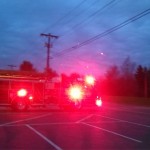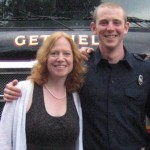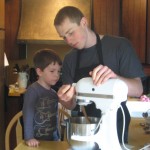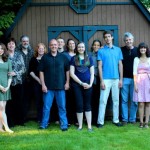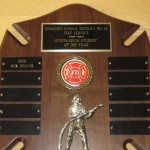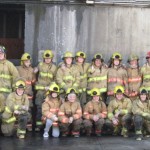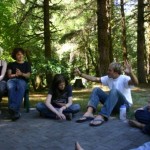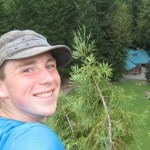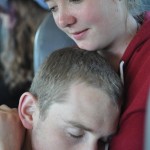
Pattern block creations by a gathering of teens last New Year’s Eve
Wooden pattern blocks are wonderful in so many ways. You can create designs with them, build with them, and play games with them. You can talk about their colors, shapes, angles, and how they relate to each other. You can lay them out in repetitive patterns or beautiful mosaics. You don’t need lessons for any of these things, only time and space to play.
The best part of playing with pattern blocks is sitting next to another person and conversing about anything and everything while you play. Years ago, Sandra Dodd wrote a beautiful essay called, Leaning on a Truck and other parallel play. She described the delights of playing with pattern blocks, along with many other wonderful side-by-side activities, and I’ve been fascinated with them ever since.
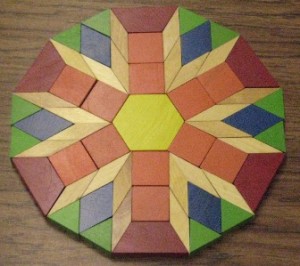
Games and Activities
Along with many freestyle uses of pattern blocks, sometimes it’s fun to use triangle paper or puzzle trays for different types of explorations. Triangle Paper is good for laying out, recording, or coloring in various shapes and geometric designs. Hexagon puzzle trays and triangle puzzle trays are good for creating contained designs that are easy to move from one place to another. Sometimes these are easier for younger children to use because they offer a framework in which to build their designs.
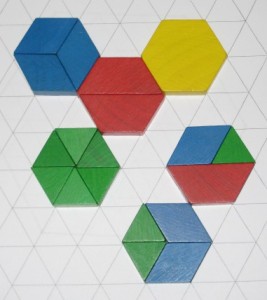
Build the Yellow Hexagon
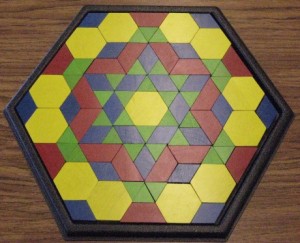
Hexagon Puzzle Tray
Build patterned designs using a variety of pattern blocks. Experiment with symmetrical and asymmetrical patterns.
Build tessellations of various shapes. A tessellation is created when a shape is repeated over and over again covering a plane without any gaps or overlaps.
Create a repeating pattern with various blocks, and then let someone else copy and complete the pattern.
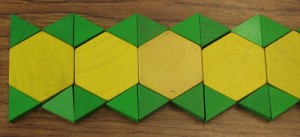
Dice Games: Use special pattern block picture dice along with regular number dice to make up your own games. Roll two, three, or four dice to determine how many and which shapes of blocks to use to create a unique design. Compare your designs with other players. Use the blocks you roll to build trains, mandalas, or asymmetrical designs.
Strategy Game: The Last Block In this game, players take turns placing pattern blocks on a hexagonal game board. The winner is the player who places the last block on the board. You can make your own hexagonal game boards of various sizes using triangle paper.
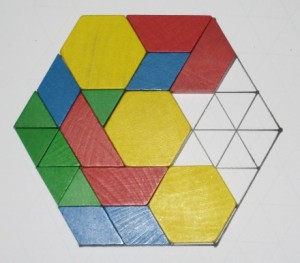
The Last Block
Hexagon Fill-in Puzzle: Use various pattern blocks to experiment with filling in a hexagon puzzle page like the one pictured below. A few questions to get you started: “How many different ways can the hexagon shape be filled?” “What’s the least number of blocks you can use to fill one of the hexagons?” “What’s the most number of blocks you can use?” This puzzle idea is adapted from the book, About Teaching Mathematics: A K-8 Resource (p.90) by Marilyn Burns. You can make your own hexagon puzzle pages using triangle paper, or get a template from Burns’s book.
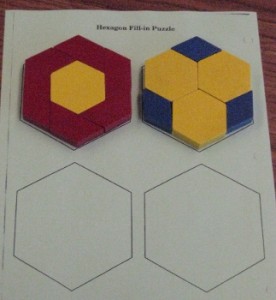
Hexagon Fill-in Puzzle
Pattern Block Design Mats, Templates, and Activity Cards: All of these can be fun to use as matching games, fill in the blank puzzles, or as pictures to color in.
- Design Mats of Animals and Flowers
- Make your own pattern block design cards by covering triangle paper with a pattern block design and coloring in the shapes to match your design.
Thinking About Angles: If you take a minute to consider some of the angles of the different pattern blocks, you might notice some similarities as well as some interesting comparisons among the blocks. Can you start with an angle you know to help you determine an angle you’re not sure about? For instance, if you know that the orange square has 90 degree angles and the green triangle has 60 degree angles, can this knowledge help you discover the angles of the other blocks?
Pattern Block Activities with Marilyn Burns: Marilyn Burns has published numerous books filled with a variety of engaging mathematical games and activities. She has much to offer in the way of thinking about math in meaningful, hands-on ways. I took a week-long workshop from her way back when I was a classroom teacher, and her enthusiasm for mathematics has stuck with me. Her books are written for classroom teachers, but if you can get past the focus on classroom methods and lessons, and the details that don’t apply, you’ll find some great activities. Even though I don’t need the teaching components from her books anymore, I still enjoy looking through them to find new ideas to play with.
- Scoop and Sort: Grab a scoop of blocks and sort them by shape.
- Build the Yellow Hexagon: How many ways can you “re-create the yellow hexagon using different assortments of blocks?” (See photo above.)
- Building Larger Shapes: “Can you use the green triangles to build a larger green triangle that is still the same shape? How many do you need?”
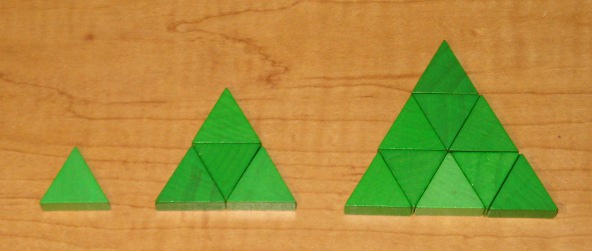
Building Triangles
Pattern Block Fraction Shapes with Cynthia Lanius: I think Cynthia asks some fun and challenging questions about how various pattern block shapes relate to each other. She offers a different way of seeing them. I would only explore these types of ideas after lots of general play with pattern blocks. Because we played with them so much over the years, it was natural for us to be fascinated by questions like these. If I had just pulled these pages out as assignments to solve, it wouldn’t be the same.
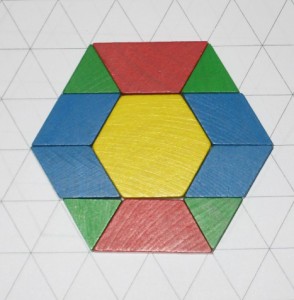
What fraction of the design is blue?
I hope you’ve found a few new ideas to play with as you explore the pattern blocks. Have fun!
Tags: art, games, mathematics, pattern blocks, what do you do all day?
Category Art, For the Love of Math, Pattern Blocks, What Do You Do All Day? |
 Predictable books are delightful for reading aloud together, and they’re great for emergent readers as they’re learning to read. Here are some of our favorites:
Predictable books are delightful for reading aloud together, and they’re great for emergent readers as they’re learning to read. Here are some of our favorites:
Over in the Meadow by Ezra Jack Keats
Benny’s Pennies by Pat Brisson
Rosie’s Walk by Pat Hutchins
Good-Night, Owl! by Pat Hutchins
Don’t Forget the Bacon by Pat Hutchins
Hattie and the Fox by Mem Fox
Across the Stream by Mirra Ginsburg
The Chick and the Duckling by Mirra Ginsburg
Have You Seen My Ducking? by Nancy Tafuri
I Went Walking by Sue Williams
Jump, Frog, Jump! by Robert Kalan
Rain by Robert Kalan
Lizard’s Song by George Shannon
Dance Away by George Shannon
Brown Bear, Brown Bear, What Do You See? by Bill Martin, Jr.
Polar Bear, Polar Bear, What Do You Hear? by Bill Martin, Jr.
So Many Bunnies: A bedtime ABC and counting book by Rick Walton
Mary Wore Her Red Dress and Henry Wore His Green Sneakers by Merle Peek
The Very Hungry Caterpillar by Eric Carle
A Summery Saturday Morning by Margaret Mahy
Who Took the Cookies from the Cookie Jar? by Bonnie Lass and Philemon Sturges
We’re Going on a Bear Hunt by Michael Rosen
One Sun: A Book of Terse Verse by Bruce McMillan
Do you and your children have any favorite predictable books?
Tags: good books, reading, what do you do all day?
Category Children's Books, Reading, What Do You Do All Day? |
 There is a great variety of children’s literature available today, so as children are learning to read, there’s no reason to give up quality of content just to gain simpler texts for young readers to enjoy. There are many easy reader series books now that are written by great authors who write real stories that children love. The content is engaging, and the characters are often funny and quite charming. Children have real reasons to read these books instead of just reading them because that’s all they are able to read. Of course, these are also wonderful books for reading aloud to children before they’re able to read independently. This is a fun way to share good stories and enjoy delightful characters together.
There is a great variety of children’s literature available today, so as children are learning to read, there’s no reason to give up quality of content just to gain simpler texts for young readers to enjoy. There are many easy reader series books now that are written by great authors who write real stories that children love. The content is engaging, and the characters are often funny and quite charming. Children have real reasons to read these books instead of just reading them because that’s all they are able to read. Of course, these are also wonderful books for reading aloud to children before they’re able to read independently. This is a fun way to share good stories and enjoy delightful characters together.
The following titles are some we enjoyed during the early years of our reading adventures.
Step-Into-Reading series
I Like Bugs by Margaret Wise Brown
I Like Stars by Margaret Wise Brown
Sunshine, Moonshine by Jennifer
Hello Reader series
A Bug, a Bear, and a Boy by David McPhail
A Bug, a Bear, and a Boy Go for a Ride by David McPhail
A Bug, a Bear, and a Boy Fly a Kite by David McPhail
A Bug, a Bear, and a Boy Paint a Picture by David McPhail
Green Light Readers series
Big, Brown Bear by David McPhail
Big Pig and Little Pig by David McPhail
Come Here, Tiger! by Alex Moran
What Day Is It? by Alex Moran
Down on the Farm by Rita Lascaro
Henry & Mudge series by Cynthia Rylant
Henry & Mudge: The First Book
Henry & Mudge In the Sparkle Days
Henry & Mudge In the Green Time
Henry & Mudge In Puddle Trouble
Henry & Mudge and the Forever Sea
Henry & Mudge and the Snowman Plan
Henry & Mudge and the Cold Shivers
Henry & Mudge and the Sneaky Crackers
Mr. Putter & Tabby series by Cynthia Rylant
Mr. Putter & Tabby Pick the Pears
Mr. Putter & Tabby Walk the Dog
Mr. Putter & Tabby Fly the Plane
Mr. Putter & Tabby Pour the Tea
Mr. Putter & Tabby Bake the Cake
Mr. Putter & Tabby Feed the Fish
Poppleton series by Cynthia Rylant
Poppleton
Poppleton and Friends
Poppleton Everyday
Poppleton in Winter
Poppleton in Spring
Poppleton Forever
The High-Rise Private Eyes series by Cynthia Rylant
The High-Rise Private Eyes: The Case of the Missing Monkey
The High-Rise Private Eyes: The Case of the Climbing Cat
The High-Rise Private Eyes: The Case of the Puzzling Possum
The High-Rise Private Eyes: The Case of the Troublesome Turtle
Dragon series by Dav Pilkey
A Friend for Dragon
Dragon Gets By
Dragon’s Merry Christmas
Dragon’s Halloween
Dragon’s Fat Cat
Frog and Toad series by Arnold Lobel
Frog and Toad Are Friends
Days with Frog and Toad
Frog and Toad Together
Little Bear series by Elsa Holmelund Minarik
Little Bear
A Kiss for Little Bear
Little Bear’s Visit
Little Bear’s Friend
Tags: good books, reading, what do you do all day?
Category Children's Books, Reading |
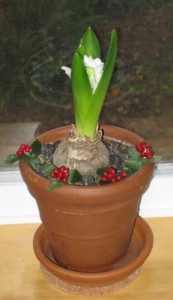 I planted this hyacinth bulb over a month ago. For several weeks, only a couple leaves were sprouting up, ever so slowly. The blossoms finally started emerging last week. Since then, it’s taken another week for the blossoms to emerge fully. I enjoyed watching the whole process, and it reminded me that growth takes time.
I planted this hyacinth bulb over a month ago. For several weeks, only a couple leaves were sprouting up, ever so slowly. The blossoms finally started emerging last week. Since then, it’s taken another week for the blossoms to emerge fully. I enjoyed watching the whole process, and it reminded me that growth takes time.
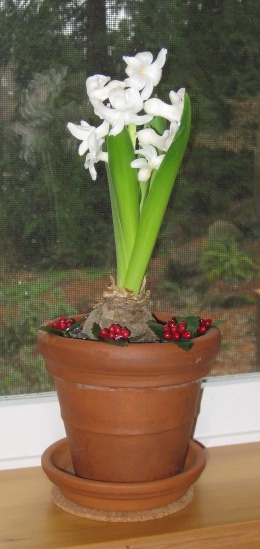
Tags: connections, creating our own path, growing up, patience
Category Connections, Creating Our Own Path, Growing Up |
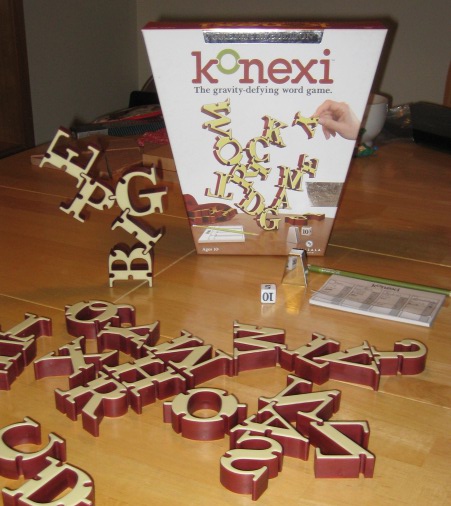
- In this game, letters can be connected in any order to form words. As you look at our small tower, can you see the words peg, pig, and big?
We recently found a great new game called konexi. It’s a 3D word-building game somewhat like Scrabble or Bananagrams plus Jenga. It’s an interactive group game with players trying to build words within the group’s connected tower of letters. Each sturdy letter has notches that allow you to fit them together, connecting them as you build upward and outward to make different words while trying to keep the tower from falling. Here’s an action shot and a close-up view of one of our games.
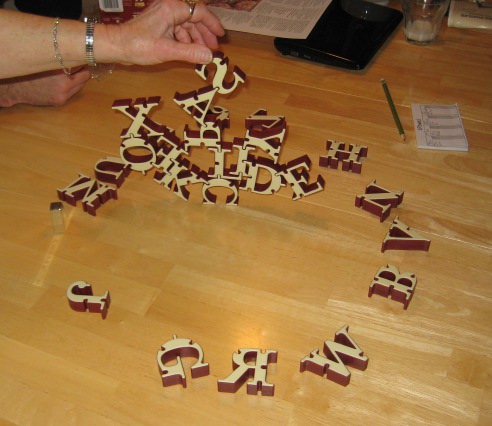
- A circle of letters to choose from with the word tower in the middle
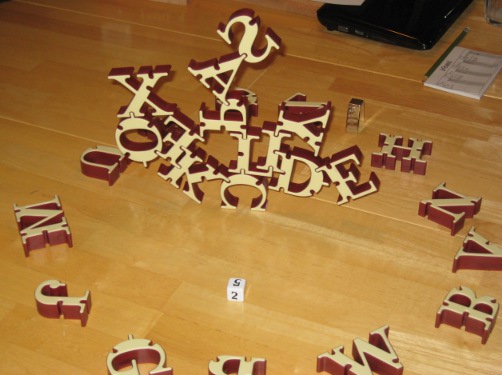
- During a Konexi game, players connect letters in all different directions to make words in any way possible. Can you find the words fox, clip, claps, clasp, laps, lid, lick, licked, lied, idle, and pails?
Tags: games, play, reading, what do you do all day?, words, writing
Category Games, Puzzles, Toys, & Tools, What Do You Do All Day? |
Picture Books with Patterned Writing, Repetitive Language and Predictable Text
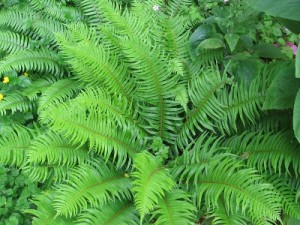 Over the years, we’ve loved reading children’s picture books filled with patterned writing, repetitive language, or predictable text. These might include alphabet books, counting books, rhyming poetry, or predictable, repetitive stories. These types of children’s books are great for reading together because children love to make predictions about what might come next in a poem or story based on following the patterns an author has chosen. These books are often the ones they ask us to read again and again. If we do, they’re likely to gain a love for beautiful language, and they’ll often internalize that language as their own.
Over the years, we’ve loved reading children’s picture books filled with patterned writing, repetitive language, or predictable text. These might include alphabet books, counting books, rhyming poetry, or predictable, repetitive stories. These types of children’s books are great for reading together because children love to make predictions about what might come next in a poem or story based on following the patterns an author has chosen. These books are often the ones they ask us to read again and again. If we do, they’re likely to gain a love for beautiful language, and they’ll often internalize that language as their own.
Books like these are the ones you’ll hear children reading along with while you’re reading aloud, even before they’re independent readers. They’re the books with text children remember and chant on their own even after you’ve finished reading. In the same way, they might be inspired to mimic some of an author’s language, some of the rhyming scheme or patterned text, and make it their own by writing their own similar stories or poems. Some children might enjoy doing this writing on their own, while others would be happy for you to transcribe their ideas for them.
The following children’s books are some that we enjoyed when Ben was younger, and a few of them inspired our own patterned writing, some of which I’ve included in other posts here.
I Like Bugs by Margaret Wise Brown
Fortunately by Remy Charlip
The Important Book by Margaret Wise Brown
A House is a House for Me by Mary Ann Hoberman
A, My Name Is Alice by Jane Bayer
Autumn: An Alphabet Acrostic by Steven Schnur and Leslie Evans
Winter: An Alphabet Acrostic by Steven Schnur and Leslie Evans
Spring: An Alphabet Acrostic by Steven Schnur and Leslie Evans
Summer: An Alphabet Acrostic by Steven Schnur and Leslie Evans
Q is for Duck: An Alphabet Guessing Game by Michael Folsom
O is for Orca: A Pacific Northwest Alphabet Book by Andrea Helman
123 Moose: A Pacific Northwest Counting Book by Andrea Helman
ABC’s of Washington State by Laurie Banks Somes
Hailstones and Halibut Bones: Adventures In Color by Mary O’Neill
* * * * * * * * * *
I hope you enjoy these wonderful books, and if you have any other favorites of your own, please share them with us in the comment section. Happy reading and writing!
Tags: connections, good books, poetry, reading, writing
Category Children's Books, Connections, Reading, Writing |
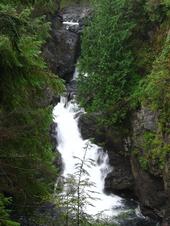 When Ben was about nine, we went with friends to an IMAX film about Lewis and Clark at the local science center. It was a great film, and we wanted to know more. We became fascinated with learning everything we could about the lives of Meriwether Lewis and William Clark. We read books, watched films, listened to music, and played games related to their expedition with the Corps of Discovery. We hadn’t planned any of this ahead of time, but it was nice the way it unfolded. The following acrostic poem was one we wrote collaboratively while immersing ourselves in their lives. It was a fun way to talk about and express some of what we had learned together.
When Ben was about nine, we went with friends to an IMAX film about Lewis and Clark at the local science center. It was a great film, and we wanted to know more. We became fascinated with learning everything we could about the lives of Meriwether Lewis and William Clark. We read books, watched films, listened to music, and played games related to their expedition with the Corps of Discovery. We hadn’t planned any of this ahead of time, but it was nice the way it unfolded. The following acrostic poem was one we wrote collaboratively while immersing ourselves in their lives. It was a fun way to talk about and express some of what we had learned together.
Lewis and Clark led the Corps of Discovery on an
Eight thousand mile expedition
West from the Missouri River to the Pacific Ocean.
Indians from many tribes helped, traded and hunted with the Corps.
Sacagawea, a Shoshone woman, guided them on their journey.
A Newfoundland dog
Named Seaman traveled with them as a faithful companion
During their many dangerous and difficult adventures.
Canoes carried them up and downstream along rivers
Like the Missouri, Clearwater, Snake, and Columbia.
Although they ventured through
Rain, rapids, and the Rocky Mountains, the Corps of Discovery
Kept pursuing their dream until the end.
* * * * * * * * * *
Here are some of the Lewis and Clark titles we enjoyed:
How We Crossed the West: The Adventures of Lewis and Clark by Rosalyn Schanzer
The Journal of Augustus Pelletier: The Lewis and Clark Expedition, 1804 by Kathryn Lasky
Will Clark: Boy Adventurer by Katharine E. Wilkie
Meriwether Lewis: Boy Explorer by Charlotta M. Bebenroth
Seaman: The Dog Who Explored the West with Lewis and Clark by Gail Langer Karwoski
Lewis and Clark and Me: A Dog’s Tale by Laurie Myers
Lewis & Clark: The Journey of the Corps of Discovery (Ken Burns’ film)
Lewis & Clark: Great Journey West (National Geographic IMAX film)
Lewis & Clark: Tools of Survival (video produced by Patrick and Patti Winters)
Lewis & Clark: Songs of the Journey (performed by Bobby Horton)
Lewis & Clark Exploration Card Game
Tags: games, good books, poems, reading, what do you do all day?
Category Children's Books, Films, Reading, What Do You Do All Day?, Writing |
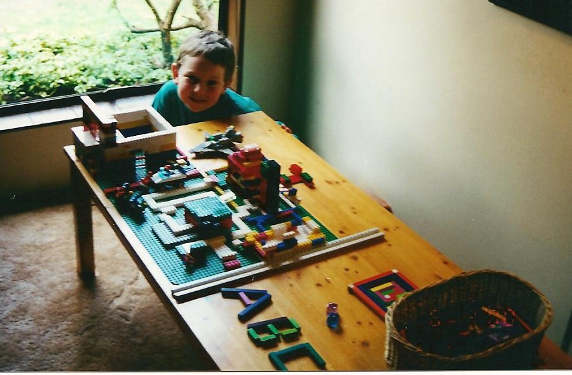
Red Legos,
Green Legos,
Blue Legos,
White Legos,
Any kind of Lego,
I like Legos!
Legos that roll,
Legos that race,
I like Legos all over the place.
Technics are my favorite.
Lego guys are too.
Axles, motors, wheels and ramps,
Next summer I’ll go to Lego camp.
Big Legos,
Tiny Legos,
Long Legos,
Short Legos,
Fat Legos,
Thin Legos,
I like Legos!
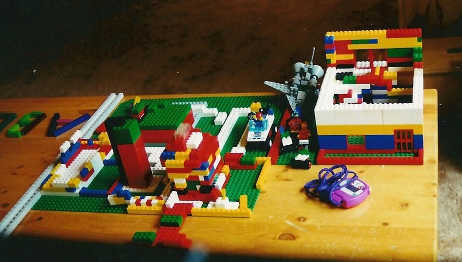
This was a poem we wrote together when Ben was 7, after years of playing with all sorts of Lego bricks and toys. We patterned it after a sweet book called I Like Bugs written by Margaret Wise Brown.
Tags: connections, good books, play, poems, reading, toys & tools, what do you do all day?
Category Children's Books, Connections, What Do You Do All Day?, Writing |
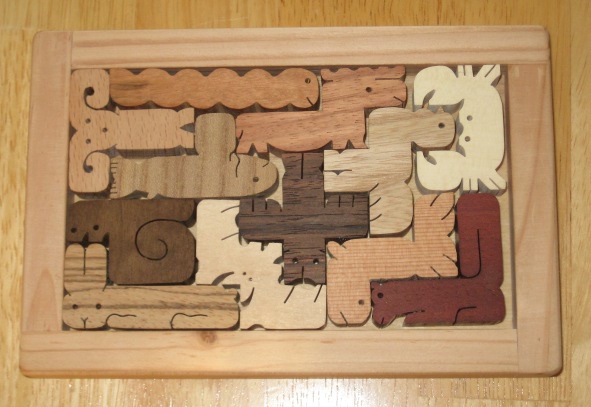
- Wooden Pentomino Puzzle
Lots of people like puzzles. They’re fun to work on individually or with friends. Some people like abstract puzzles on paper or in books, while others like the hands-on, three-dimensional variety. Here are some of the many puzzles we’ve enjoyed over the years.
Crossword puzzles
Word search puzzles
Dot to Dot books
Highlights Puzzlemania
Highlights Mathmania
Usborne Young Puzzle Books
Sudoku
Jigsaw puzzles
Floor puzzles
Tangrams
Solid wooden pentominoes
Wooden animal pentomino puzzle
Izzi: The Puzzle With Almost a Zillion Solutions
Metal disentanglement puzzles
Rush Hour: Traffic Jam Game
Gordian’s Knot: Brainteaser Challenge
Block by Block: Creative Building Game
Snake Cube Solitaire Puzzle
Tags: mathematics, play, problem solving, puzzles, what do you do all day?
Category Books and Resources, Games, Puzzles, Toys, & Tools |
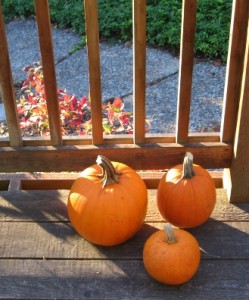
- Home grown small sugar pumpkins
I love the changing of the seasons, and as homeschoolers we get to enjoy each of them, especially as they blend gradually from one season to the next. Sometimes, in August, people ask me if things change for us much from August to September. The answer to that is usually, “No, not really.” When everyone else is gearing up for a faster pace, we tend to slow down and savor the autumn months. It’s cooler, so we don’t need to water the gardens as much, and the daylight hours are somewhat shorter, but there’s no big back to school panic or hurry up and get ready for a whole new year. Where we live, September is often sunny, so it feels like we get a little extra summertime. We can meander toward autumn slowly without abruptly saying goodbye to summer. We get a few extra weeks of non-rainy days for bike riding or other outdoor activities with homeschooling friends who are also not rushing back to school.
If, in early September, we started busying ourselves with curriculum, assignments, and numerous classes, we wouldn’t have time to do the things that are really important to us. We wouldn’t have time to enjoy the autumn air, the seasonal harvests, and other autumn opportunities that might arise. As it is, we take our time finding out what we want to learn, how we want to spend our time, and staying connected with each other.
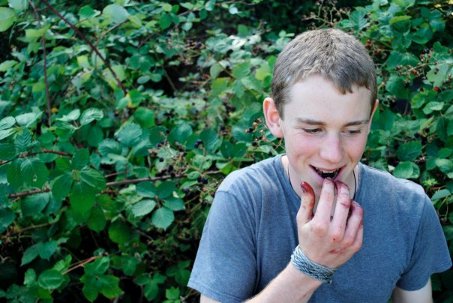
- Ben picking blackberries at camp, age 16
In late August and early September, Ben enjoys a couple weeks in Oregon at Grace Llewllyn’s Not Back To School Camp. He’s been attending annually since he was thirteen. He so looks forward to this time to reconnect with old friends, make new friends, relax, and learn new things with all of them. During these weeks, Don and I enjoy some time together relaxing, gardening, bike riding, and doing outdoor projects while the weather is still cooperating.
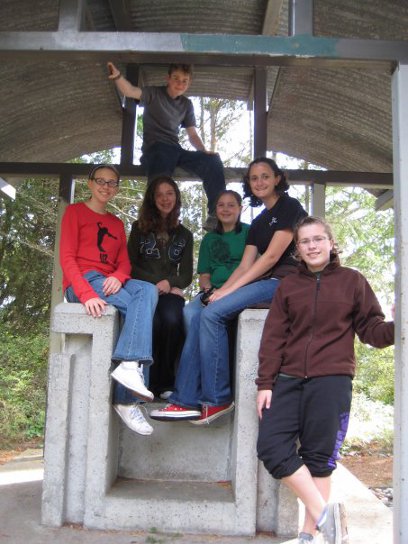
- Exploring old forts with friends, age 15
Later in the fall, we might plan a short family trip or weekend adventure after all the summer crowds have dispersed. For a couple years now in October, we’ve joined friends from our homeschool group for a weekend in Port Townsend at a hostel near some old historic forts, beaches, and a great marine science museum. We share a variety of experiences together during these trips, and it’s a nice way to connect with each other before everyone gets busy with their own individual routines and pursuits.
At home, we harvest pumpkins, winter squashes, and apples from our gardens. We take time to make applesauce as well as preserve other fruits to enjoy during winter. We get the garden beds prepared for early spring planting, too. These things take time, and we’re glad to be able to plan for them along with other autumn adventures.
Sometimes Ben signs up for a new class or two in the fall. This is a time when new opportunities are offered, like a metalworking class at the arts center or a first aid class at the local alternative school. In the past, he’s joined other homeschooled friends for a community center ceramics class or an open gym time. This year he’s working in a fire service training program a couple hours a day. Along with these, there are also park days or other activities with our homeschool group that seem to start up again as well.
Mostly, however, autumn is a time for us to hunker down at home, read new books, play games, and work on projects that interest us. One year that might mean reading as much as possible about backpacking and then sewing backpacks from a kit. Another year, there’s time to work on building the perfect electric bass guitar, research the best guitar parts, read about the electronics involved, and learn to play some favorite songs.
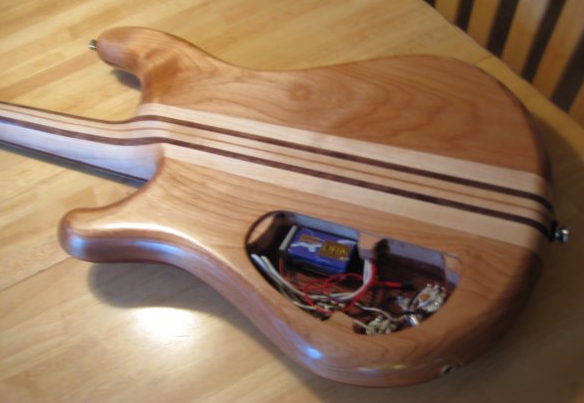
- Ben's hand built electric bass guitar: view of the electronics and neck-through design using a laminate construction of maple, walnut, & cherry
Other seasons of the year continue in a similar fashion, each in their own way. There are birthdays and holidays to celebrate, friends to spend time with, more books and projects, and dozens of things to find out about.
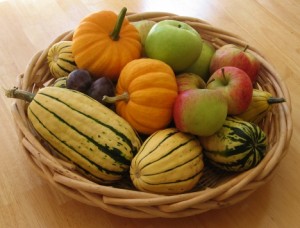
Tags: adventures, autumn, creating our own path, projects, what do you do all day?
Category Adventures, Creating Our Own Path, Projects, What Do You Do All Day? |
 Pattern block creations by a gathering of teens last New Year’s Eve
Pattern block creations by a gathering of teens last New Year’s Eve
 Build the Yellow Hexagon
Build the Yellow Hexagon
 Hexagon Puzzle Tray
Hexagon Puzzle Tray
 The Last Block
The Last Block
 Hexagon Fill-in Puzzle
Hexagon Fill-in Puzzle
 Building Triangles
Building Triangles
 What fraction of the design is blue?
What fraction of the design is blue?


 Predictable books
Predictable books















